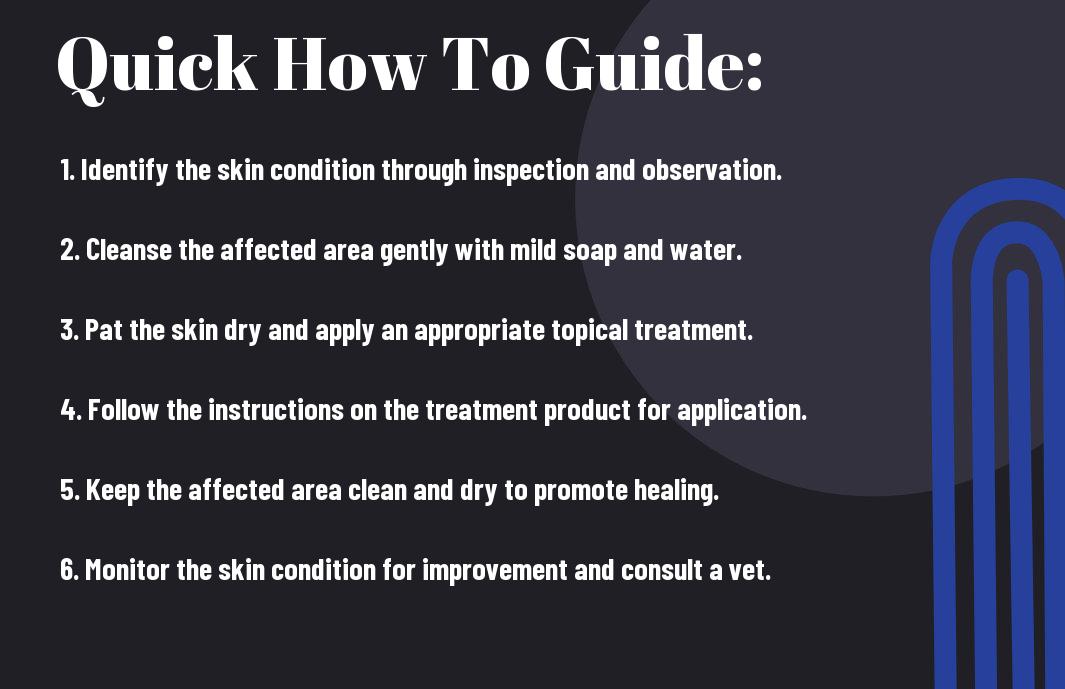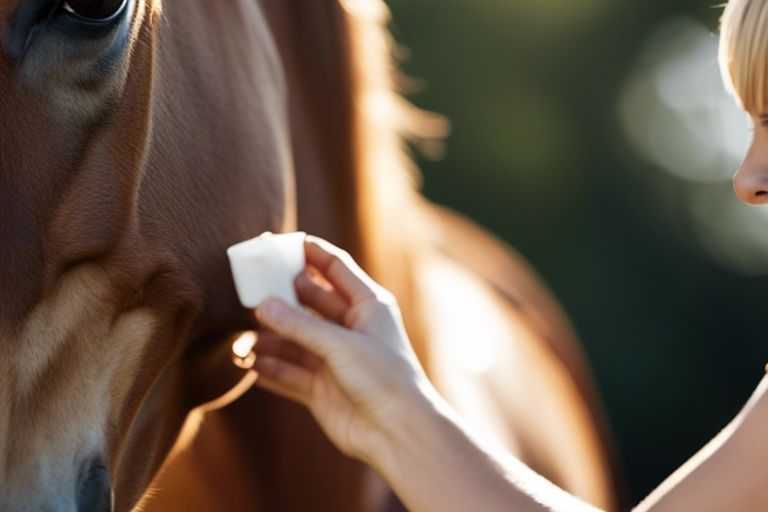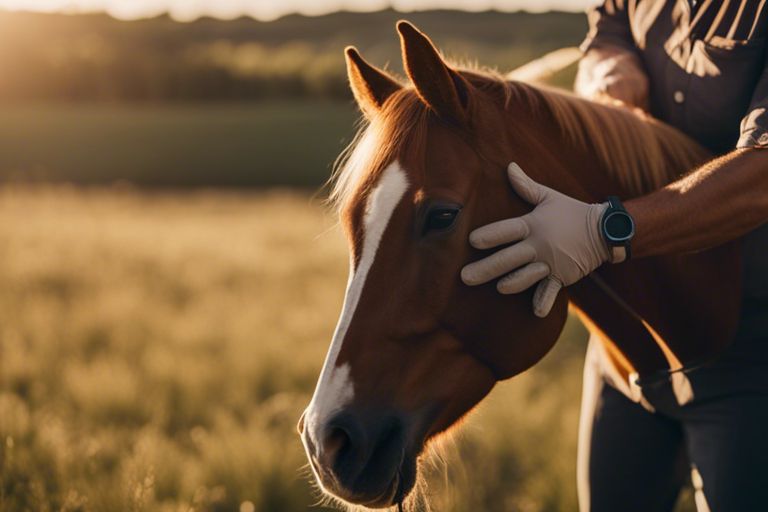There’s nothing more distressing than seeing your beloved horse suffer from skin conditions. However, with the right knowledge and care, you can effectively manage and treat these common issues. This guide will walk you through identifying, treating, and preventing skin conditions in your horse, ensuring they stay healthy and comfortable.


Understanding Horse Skin Conditions
Identifying Common Skin Conditions in Horses
To effectively treat skin conditions in horses, you first need to be able to identify them. Common skin conditions in horses include sweet itch, rain rot, grease heel, dermatophilosis, and ringworm. Sweet itch is a seasonal allergic skin reaction to midge bites, while rain rot is a bacterial skin infection often seen in damp conditions. Grease heel, also known as scratches, is a dermatitis affecting the pastern and heel area. Dermatophilosis, or rain scald, is caused by a bacterium and thrives in wet environments. Ringworm is a fungal skin infection that can spread quickly among horses in close contact.
Factors Contributing to Skin Conditions in Horses
Horses can develop skin conditions due to various factors. These include poor hygiene practices, inadequate diet and nutrition, allergies to environmental factors, fungal or bacterial infections, and parasites like mites. Ensuring your horse has a clean living environment, a balanced diet, and proper grooming can help prevent skin issues. Regular vet check-ups can also help detect and address any underlying health concerns that may contribute to skin problems. This proactive approach can significantly reduce the risk of skin conditions in your horse.
This comprehensive care routine is important for maintaining your horse’s skin health and overall well-being. By addressing these contributing factors, you can help keep your horse’s skin in top condition and prevent common skin issues.
Importance of Early Detection and Treatment
Any skin condition left untreated can worsen and potentially cause discomfort or harm to your horse. Early detection and treatment are crucial in preventing skin conditions from escalating. Skin conditions such as dermatitis or fungal infections can spread rapidly and lead to more severe complications if not addressed promptly. It is important to monitor your horse’s skin regularly, especially after turnout in damp or muddy conditions, and seek veterinary advice at the first sign of any abnormalities.
It is vital to remember that prompt action is key to protecting your horse from unnecessary suffering and ensuring their skin remains healthy. By being proactive in monitoring and addressing skin issues, you can maintain your horse’s comfort and well-being.
How to Diagnose Horse Skin Conditions
Visual Inspection and Examination Techniques
With a keen eye and proper techniques, you can conduct a visual inspection of your horse’s skin to identify any abnormalities or conditions. Start by examining your horse in good lighting conditions, looking for changes in color, texture, or thickness of the skin. Check for any lesions, bumps, scabs, or swellings that may indicate a skin condition. Gently palpate the affected areas to assess tenderness or heat, which can provide clues about the nature of the condition.
Diagnostic Tests and Procedures
Skin conditions in horses can sometimes be challenging to diagnose based solely on visual inspection. In such cases, diagnostic tests and procedures may be necessary to determine the underlying cause of the issue. Your veterinarian may recommend skin scrapings, fungal cultures, biopsies, or blood tests to help identify the specific condition affecting your horse.
Conditions such as allergies, fungal infections, bacterial infections, or parasitic infestations may require specific tests to confirm the diagnosis. These tests can provide valuable information that will guide the treatment plan for your horse.
Tips for Accurate Diagnosis
There’s no one-size-fits-all approach to diagnosing horse skin conditions, but there are some tips that can help you achieve an accurate diagnosis. When examining your horse’s skin, pay attention to any changes in behavior, such as itching, rubbing, or discomfort. These signs can offer valuable clues about the nature of the condition.
- Consult a veterinarian if you are unsure about the nature of the skin condition.
- Keep detailed records of any changes in your horse’s skin condition over time.
- Perceiving the progression of the symptoms can help your veterinarian make an accurate diagnosis and treatment plan.
Treating Skin Conditions in Horses
Topical Treatments and Creams
Keep your horse’s skin clean and dry to prevent further irritation and infection. When treating skin conditions in horses, topical treatments and creams can be very effective. Look for products containing ingredients like antibiotics, antifungals, or corticosteroids depending on the specific condition. Apply the cream as directed by your veterinarian, usually by gently massaging it into the affected area.
Oral Medications and Supplements
On top of topical treatments, sometimes skin conditions in horses may require oral medications and supplements to help with healing from the inside out. Your vet may prescribe antibiotics, antihistamines, or omega-3 fatty acids to address the underlying causes of the skin issue. Follow the recommended dosage and treatment duration carefully to ensure the best results.
Creams, ointments, and sprays containing important fatty acids, biotin, and zinc can also be beneficial for promoting healthy skin and coat in horses. Discuss with your vet to determine the best oral medications and supplements for your horse’s specific skin condition.
Natural Remedies and Alternative Therapies
Horses with sensitive skin may benefit from natural remedies and alternative therapies to treat skin conditions. Ingredients like aloe vera, tea tree oil, and calendula have soothing properties that can help calm irritation and promote healing. Additionally, therapies such as acupuncture or chiropractic care can help address underlying imbalances contributing to skin issues.
Anytime you are considering using natural remedies or alternative therapies for your horse’s skin condition, it’s important to consult with your vet first. Some natural ingredients may cause adverse reactions or interact with other medications your horse is taking.
Managing Skin Conditions in Horses
Now, when it comes to managing skin conditions in horses, there are several factors you need to consider to keep your horse’s skin healthy and problem-free.
Environmental Factors to Consider
There’s no denying that environmental factors play a significant role in the development and management of skin conditions in horses. Here are some key points to keep in mind:
- Proper shelter and turnout: Ensure your horse has access to shelter to protect against extreme weather conditions.
- Clean living environment: Regularly clean your horse’s stall and paddock to reduce exposure to irritants.
- Quality bedding: Use dust-free bedding to prevent respiratory issues and skin irritation.
Any changes in your horse’s environment should be made gradually to avoid stress and potential skin reactions.
Nutrition and Diet Tips for Healthy Skin
Factors like nutrition and diet can also have a significant impact on your horse’s skin health.
- Proper hydration: Ensure your horse has access to fresh, clean water at all times.
- Balanced diet: Provide a diet rich in crucial vitamins and minerals to support overall skin health.
- Omega-3 fatty acids: Incorporate sources of omega-3s, such as flaxseed or fish oil, to promote healthy skin and a shiny coat.
Knowing what nutrients are crucial for skin health can help you tailor your horse’s diet accordingly.
Grooming and Hygiene Practices
Environmental factors such as grooming and hygiene practices play a crucial role in maintaining your horse’s skin health.
- Regular grooming: Brushing your horse regularly helps stimulate oil production and remove dirt and debris from the skin.
- Bathing: Use gentle, horse-friendly shampoos when bathing your horse to avoid stripping the skin of its natural oils.
Nutrition and proper grooming techniques can go a long way in preventing skin conditions and maintaining your horse’s overall well-being.

Preventing Skin Conditions in Horses
Vaccinations and Preventative Care
For your horse’s overall health and well-being, it is crucial to stay up to date with vaccinations and preventative care measures. There’s a range of vaccines available to protect your horse from common diseases that can lead to skin conditions. Consult with your veterinarian to create a customized vaccination schedule tailored to your horse’s specific needs.
Parasite Control and Management
To prevent skin conditions caused by parasites, such as sweet itch or rain rot, you must prioritize parasite control and management. To effectively control parasites, administer deworming treatments regularly as recommended by your vet. Additionally, practice good manure management in your horse’s living environment to minimize parasite infestation.
Plus, ensure your horse has access to clean water and a balanced diet to support a healthy immune system, which can help your horse fight off potential skin conditions more effectively.
Reducing Stress and Promoting Overall Health
To prevent stress-related skin conditions, focus on creating a safe and comfortable environment for your horse. Adequate turnout time, social interaction with other horses, and a consistent routine can all contribute to your horse’s mental well-being. Additionally, provide enrichment activities and monitor your horse for signs of stress or discomfort.

Advanced Treatment Options
- Surgical Interventions for Severe Skin Conditions
Procedure Description Debridement Removal of dead or infected tissue to promote healing. Skin Grafting Transplanting healthy skin to the affected area. - Laser Therapy and Other Advanced Treatments
Treatment Description Laser Therapy Use of concentrated light beams to target specific skin issues. Cryotherapy Freezing of abnormal skin cells to treat conditions like sarcoids.
Advanced Surgical Interventions: When common treatments are ineffective, surgical options may be necessary for severe skin conditions in horses. Debridement involves the removal of dead or infected tissue to facilitate healing, while skin grafting may be performed to transplant healthy skin to the affected area.
Laser Therapy and Other Advanced Treatments: Laser therapy offers a targeted approach to treating skin conditions by using concentrated light beams to address specific issues. Additionally, cryotherapy, which involves freezing abnormal skin cells, can be effective in treating conditions such as sarcoids.
When to Seek Professional Help
An early consultation with a veterinarian is crucial if you notice: persistent or worsening skin conditions, lesions that are not responding to treatment, or any signs of infection like discharge or foul odor. Professional intervention can prevent the condition from worsening and ensure the best outcome for your horse’s skin health.
Laser therapy: can provide effective treatment for a variety of skin conditions in horses, including dermatitis, wounds, and even tumors. The precision of laser therapy allows for targeted treatment with minimal damage to surrounding tissues, making it a valuable tool in managing complex skin issues.
Conclusion
With this in mind, it is crucial to be proactive in caring for your horse’s skin to prevent common conditions from occurring. By implementing a proper grooming routine, maintaining a clean living environment, and feeding a balanced diet, you can help keep your horse’s skin healthy and free from issues.
Remember to regularly monitor your horse for any signs of skin conditions and seek veterinary care if needed. By staying vigilant and taking preventive measures, you can ensure your horse’s skin remains in optimal condition, allowing them to be comfortable, happy, and at their best.
FAQ
Q: What are some common horse skin conditions?
A: Some common horse skin conditions include rain rot, ringworm, sweet itch, and mud fever.
Q: How can I prevent horse skin conditions?
A: To prevent horse skin conditions, ensure your horse is properly groomed, stabled in clean and dry conditions, and avoid sharing grooming tools or tack with other horses.
Q: How do I treat rain rot in horses?
A: To treat rain rot in horses, remove the scabs gently with warm water and gentle shampoo, then apply an antibacterial or antifungal ointment as recommended by your veterinarian.
Q: What is the best way to manage sweet itch in horses?
A: To manage sweet itch in horses, use fly sheets, fly masks, and insect repellents to minimize exposure to biting insects, and consult with your veterinarian for treatment options such as corticosteroids or antihistamines.
Q: Can I treat ringworm in horses at home?
A: While mild cases of ringworm in horses can be treated at home with antifungal shampoos or creams, severe cases may require veterinary intervention with oral medications or topical treatments.











